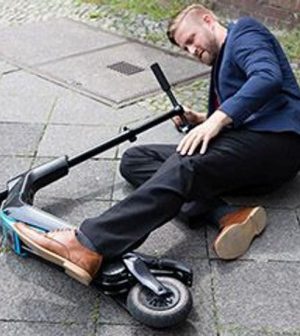- Understanding the Connection Between Anxiety and Depression
- How Daily Prunes Can Influence Cholesterol and Inflammation
- When to Take B12 for Better Absorption and Energy
- Epsom Salts: Health Benefits and Uses
- See What Saffron Can Do for Sleep and Heart Health
- 6 Common Mistakes to Avoid Before Your Physical
- Can Sweating Really Help You Beat a Cold?
- Strengthening Your Relationship: Practical Strategies
- Skip Storing This Everyday Product in the Fridge Door
- Green Tea + B3 Pairing May Boost Brain Health
L.A. Study Shows E-Scooter Injury Rate Soaring

Electric scooters may be a boon for the environment but not so much for riders.
A surprising study finds that the injury rate in one Los Angeles neighborhood for riders of e-scooters topped that for users of motorcycles, bicycles and cars nationwide.
“There are millions of riders now using these scooters, so it’s more important than ever to understand their impact on public health,” said senior author Dr. Joann Elmore, professor at David Geffen School of Medicine at the University of California, Los Angeles (UCLA). “The finding that rates of injuries from e-scooters are similar to rates for motorcycle injuries is startling.”
Here’s how it breaks down: The study estimated 115 injuries for every one million e-scooter trips. The closest comparison is 104 injuries per million motorcycle trips, according to a 2007 study.
In all, there are 15 injuries for every million bicycle trips; eight per million passenger car trips; and two per million walking trips, the study authors said.
A 2019 McKinsey report estimated that e-scooters could soon account for one in 10 trips shorter than five miles.
“The ease of public access to on-demand shareable scooters and safety regulations that are still in their infancy suggest that e-scooter operators, cities and health care providers will continue to see a significant number of injuries each year,” Elmore said in a UCLA news release.
For the study, her team looked at 1,354 people who were treated at UCLA outpatient clinics, emergency departments and urgent care centers between Jan. 1, 2014, and May 14, 2020, both before and after the emergence of shareable e-scooters in that area.
The injuries included head trauma and broken bones. In all, 533 people were injured in more than one part of their bodies; 72 were admitted to the hospital; 21 were sent to the critical care unit; and two died. The injured included riders; pedestrians hit by moving scooters; and people who tripped over parked scooters.
“Overall, 33% of victims required substantial subsequent therapeutic clinical resources from our health system beyond a single clinical visit,” the researchers concluded. “Therefore, the impact of novel e-scooter technology may have been underestimated by early studies of [emergency department] visits alone.”
Injuries surged after the shareable scooter was introduced in 2018, the study authors pointed out.
Before that, there were at most 13 e-scooter injuries a year, the findings showed. “After introduction of shareable e-scooter operators in our region, e-scooter injuries increased to 595 and 672 in 2018 and 2019, respectively,” the team reported.
The researchers noted that only data from UCLA Health facilities were included, so injury numbers may actually be higher for the region.
According to study first author Dr. Kimon Ioannides, “It is important to note that e-scooter injuries may be less severe and less fatal than motorcycle injuries, but we still think our e-scooter injury rate is an underestimate.” Ioannides led the study as a postdoctoral fellow at the UCLA National Clinician Scholars Program.
The findings were published April 6 in the journal PLOS ONE.
More information
The U.S. Consumer Product Safety Commission has more on e-scooter, e-bike and hoverboard injuries.
SOURCE: University of California, Los Angeles, news release, April 6, 2022
Source: HealthDay
Copyright © 2026 HealthDay. All rights reserved.










